

Observing with Stellafane's Schupmann
Some thoughts about my first observing session with the McGregor Observatory
By Carl Breuning, Springfield Telescope Makers
It was Thanksgiving evening and clear in Newport, New Hampshire. I could feel the pull of Stellafane, as the clear skies faded to a dark purple. Stellafane has that effect on those of us in the Springfield Telescope Makers, and often we find ourselves driving up Breezy Hill Road to the observatories in anticipation of seeing our old friends above.
After entering the McGregor observatory and disarming the alarm system, my wife, daughter, son in law and my grandchildren headed for the warming room. It was quite chilly but not real cold, but soon the electric heaters began to warm our spirits.
Tonight was a special evening for me. I'd never before used the imposing Schupmann Telescope that sits in the cold of the observing area. It was a make or break night for me. The week before had seen me in the learning process during the daytime, making mock sightings or looking at the Sun through the filter installed ahead of the objective lens. This was different though. I had my family as guests and would feel silly if I didn't manage to operate it correctly.
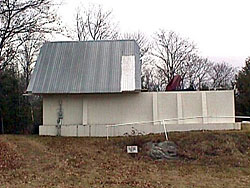
with roof rolled back.
I began by flipping the hydrostatic pressure switch that lifts the beautiful telescope a few ten thousandths of an inch, to provide a near frictionless oil bearing. As the switch found it's position I could hear the pump below the observatory floor go into action as it hummed a muted song. Turning on the electrical drive motors for the telescope, I could spot the light coming out of the computer cabinet. I engaged the relays for the roof control and edged back the roof. As the roof slowly moved into it's open position my eyes met the stars above.
Opening the computer cabinet, I was greeted by the warm glow of the monitor. Beginning with a fresh restart, the computer control program soon came into view. After minimizing the control program, I then double clicked on the planetarium program that would soon allow me to see my friends close up.
Soon the telescope was mere putty in my hands as I trained and elevated it into position. I peered through the Telerad finder and lined up on Algenib, or Gamma Pegasus, a 2.8 magnitude star high above. I used the hand controller to slew to the star that would allow me to synchronize the telescope with the planetarium program.
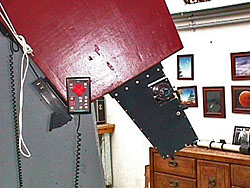
box of the telescope.
After guiding the telescope into the bulls eye circle of the Telerad finder I peered into the eyepiece and found it near dead center. A slight nudge corrected it to the exact center. Then it became a simple matter to synchronize the telescope. I was 'N Sync as the musically inclined kids today say.
Looking up to the East I saw the two of them. Jupiter and Saturn were glowing fiercely in the dark sky, almost burning a hole in the fabric of the darkness. I clicked onto the screen's representation of the planet Jupiter and watched as the telescope began its journey across the heavens. The screen told me it should be centered on the gargantuan planet but would it really be there when I looked into the eyepiece? Stepping to the ladder I climbed into position to see a bright light in the eyepiece long before my eye slipped into place. Wow! What a sight. The gigantic planet loomed in the exact center of the eyepiece.
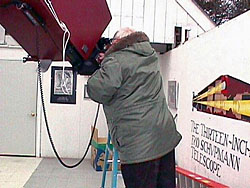
with the telescope.
There were weather bands and festoons in abundance. There were a couple of Moons nearby. What was that? Could it be? The famous red spot loomed into view. It was more brownish than red, but there it was. I couldn't believe my eyes. Was I dreaming? No, it was there, right before me. I'd seen it many years ago in the Porter Turret.
When I see such beauty, it brings a lump in my throat. I can't adequately express my joy at once more seeing this beautiful sight, and for the first time in the new Schupmann Telescope. One by one, my reluctant family came out of the warming room. They were warm and didn't relish the cold. They instantly had their breath taken away but not from the cold night air. It was only after looking into the eyepiece and sighting Jupiter in all his glory.After many minutes of enjoyment, we felt the need to focus on Saturn. The great telescope came to life and smoothly slewed over and upward into track. Again I was apprehensive as I climbed the ladder to see if I had found my quarry. I need not have worried. The ringed planet was the clearest I've ever seen floating there in the darkness before my eyes. Cassini's division could be seen completely around the planet's ring system. Markings on the planet itself came into view, and it seemed as if a beehive of tiny stars surrounded the ball. They were of course, the Moons of Saturn and were amazing to behold. Even the shadow of the rings were imprinted on the ball of the planet.
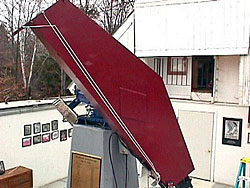
Schupmann Refractor.
We drank in the wonders of Saturn for many minutes before numbing fingers decided we should retire to the warming room. My daughter, Cheri, made turkey sandwiches and boiled water for hot chocolate. Cold fingers grasped the cups and soon began to thaw. It didn't take long to feel the itch for more observations.
Entering the telescope arena I gazed in awe one last time at Saturn, still holding steady in the eyepiece, before I began slewing to M38. The Auriga Open Clusters are some of the finest to be seen in the early winter skies. Most are fairly large and this one required low power to fully see its 21' diameter. Everyone had their chance to stand at the eyepiece and Oooh and Aaah until we moved over to the next cluster; M36. Then it was M37 and we finished with M35. Each has it's own diamond-like appearance in the sky. Jewelry like this is not bought. It belongs to us all. We need only use our eyes to peer at them and wonder.
We checked on one or two of the Seven Sisters of the Pleiades for nebulosity in the region of Electra and Merope. The sisters were beautiful and bright, but I detected no nebulosity. "Why?" I wondered. Looking up at the dipper-shaped asterism, it became instantly apparent. Clouds. Oh no! The bane of the amateur astronomer, clouds were sliding into view. Our viewing was limited.?
Would I be able to see my favorite object in time? Quickly I returned to the red-screened television monitor and clicked on M42, the Great Orion Nebula. The telescope tilted downward and trained slightly left as it centered on the target.
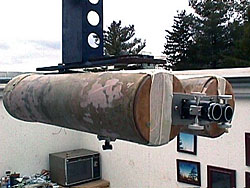
as a counterweight.
Now it required that I step a bit higher on the stepladder as I climbed to the eyepiece. Looking in I saw it in its glorious spectral vision. What a sight. The Trapezium's four stars centered on the eyepiece, while the glow of nebulosity cloaked them. The entire eyepiece was bathed in the beautiful light of the Orion Nebula. I can never get enough of this amazing vista. Many a time I hog the eyepiece for many minutes just marveling at this mystical light. Practically torn from the ladder, my family, one by one, climbed up to be greeted by the same vision, before the clouds occluded our sight.
Closing down is always a sad time when clouds come by, but this time, I had a warm glow of satisfaction at having been privileged to use this remarkable instrument. I feel very humbled at being able to use the telescopes of the Springfield Telescope Makers. We have two of the most remarkable telescopes in the entire world and some of the most talented members who have made them. The Schupmann is a marvel of engineering magnificence. It is a monument to it's creators that will endure for decades.
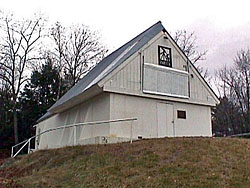
with roof closed.
Yes, you can stay at home and look at CCD images taken at higher resolutions through great instruments, but until you have actually looked through a telescope and drunk in the beauty with your own eyes, you have not seen, you have merely looked.
Stowing the telescope and the building, we drove down the gravel road behind the red taillights of the car before me. Clouds drifted in and fog broke out here and there as my thoughts returned to my first evening of heavenly explorations using the remarkable World's Largest Schupmann telescope. Success is sweet.
The Heavens Declare The Glory of God.
Carl Breuning, proud to be an STM
All photos associated with this article are the property of Carl Breuning unless otherwise noted.
Back to the McGregor-Schupmann Page